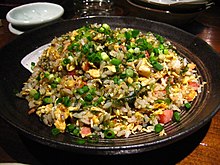Chahan(Japanese:チャーハン/ cơm chiên,Hepburn:chāhan),also known asYakimeshi(Japanese: Thiêu cơm or thiêu き cơm ), is a Japanesefried ricedish prepared withriceas a primary ingredient and myriad additional ingredients andseasonings.The dish is typically fried, and can be cooked in awok.Chahanmay have originated in the 1860s from Chinese immigrants arriving at the port ofKobe.Chahanis astaple foodin homes in Japan.[1]Some restaurants outside Japan serve the dish as a part of their fare.
 | |
| Alternative names | チャーハン/ cơm chiên |
|---|---|
| Associatedcuisine | Japan |
| Created by | Chinese immigrants |
| Invented | 1860s |
| Main ingredients | Fried rice |
History
editChahanmay have originated fromChinese immigrantswho arrived at the port ofKobe,Japan in the 1860s. InChinese,fried rice is calledchǎofàn(Cơm chiên); these sameChinese charactershave aJapanese readingofChāhan.[2]
Preparation
editChahanis a Japanesefried ricedish that is typically cooked in awok.[3][1]Rice is used as a primary ingredient, and a wide range of additional ingredients can be used including scrambled egg, vegetables, onion, garlic, edible mushrooms such asshiitake,tofu,pork, as well asseafoodssuch as crab meat, roe, and shrimp.[1][4][5][6][7]Oils such as canola oil, sesame oil and sunflower oil are used to fry the dish.[1][6]The dish can beseasonedwith soy sauce, oyster sauce, sesame oil, salt, pepper andkatsuobushi,a dried and flaked tuna product.[6][7]Shiso,an Asian culinary herb, may also be used to flavorchahan.[8]Nori,a driededible seaweedproduct, can be used as agarnish.[8]
The use of a hot wok for frying and cookingchahanquickly can prevent the rice from sticking to the pan, and using warm rice also prevents pan sticking.[2]The use of pre-cooked and refrigerated rice is also conducive toward enhancing the cooking process.[1][8]
Variations
editTakana chahanis prepared with takanazuke (pickledtakana) as a primary ingredient.
See also
edit- Japanese cuisine
- List of fried rice dishes
- List of Japanese dishes
- List of rice dishes
- Omurice– Western-influenced Japanese dish consisting of an omelette with rice
References
edit- ^abcdeSamuels, D.; Robbins, H. (2013).My Japanese Table: A Lifetime of Cooking with Friends and Family.Tuttle Publishing. p. pt272–273.ISBN978-1-4629-0638-3.
- ^abOno, T.; Salat, H. (2013).Japanese Soul Cooking: Ramen, Tonkatsu, Tempura, and More from the Streets and Kitchens of Tokyo and Beyond.Potter/TenSpeed/Harmony. pp. 397–398.ISBN978-1-60774-353-8.
- ^Sakamoto, T.; Ltd, M.C.I.P. (2013).Cook Japanese with Tamako: Hearty Meals for the Whole Family.Marshall Cavendish International (Asia) Private Limited. pp. 32–33.ISBN978-981-4516-87-7.
- ^Hachisu, N.S.; Miura, K. (2012).Japanese Farm Food.Andrews McMeel Publishing. p. 152.ISBN978-1-4494-1829-8.
- ^Stallings, D.; Butler, S.E. (2011).Fodor's Japan.Fodor's. p.834.ISBN978-0-307-48049-1.
- ^abc"Receita de tako chahan: arroz frito com polvo e cogumelo shitake".Mundo-Nipo(in Portuguese). September 14, 2015.RetrievedApril 25,2016.
- ^ab"Receita de ninniku chahan: arroz frito com alho, shissô e katsuobushi".Mundo-Nipo(in Portuguese). July 15, 2015.RetrievedApril 25,2016.
- ^abc"Garlic Fried Rice (Chahan)".The Washington Post.April 22, 2016.RetrievedApril 25,2016.